
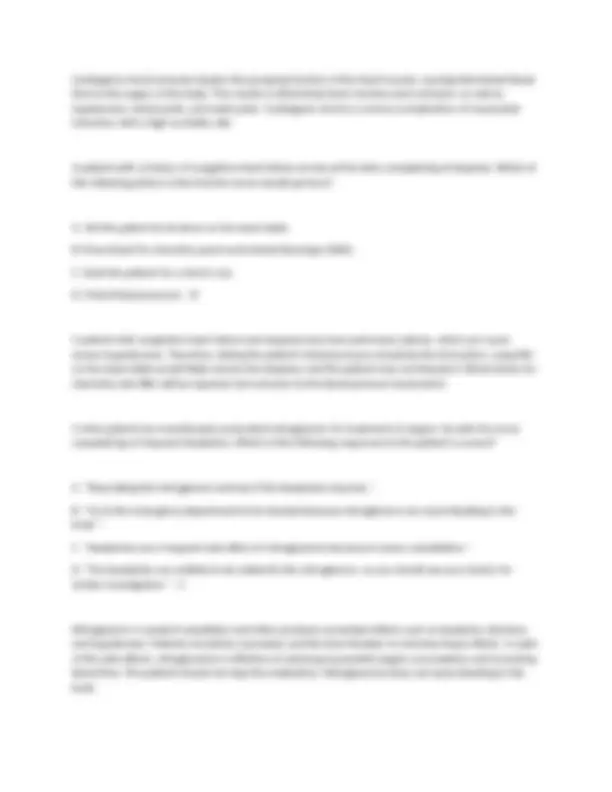
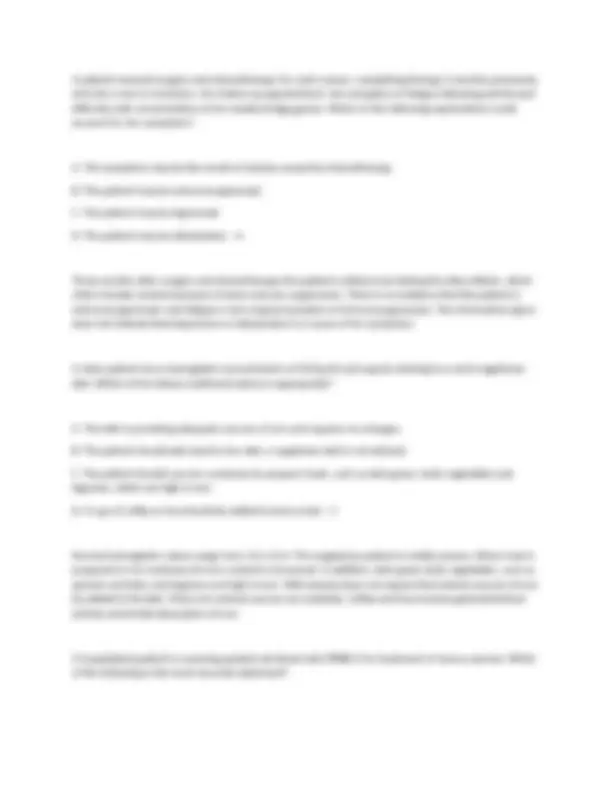
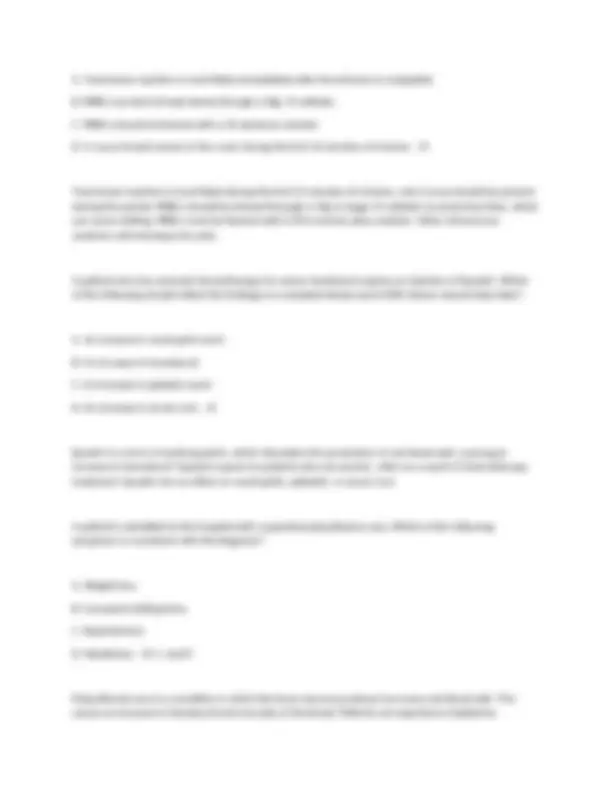
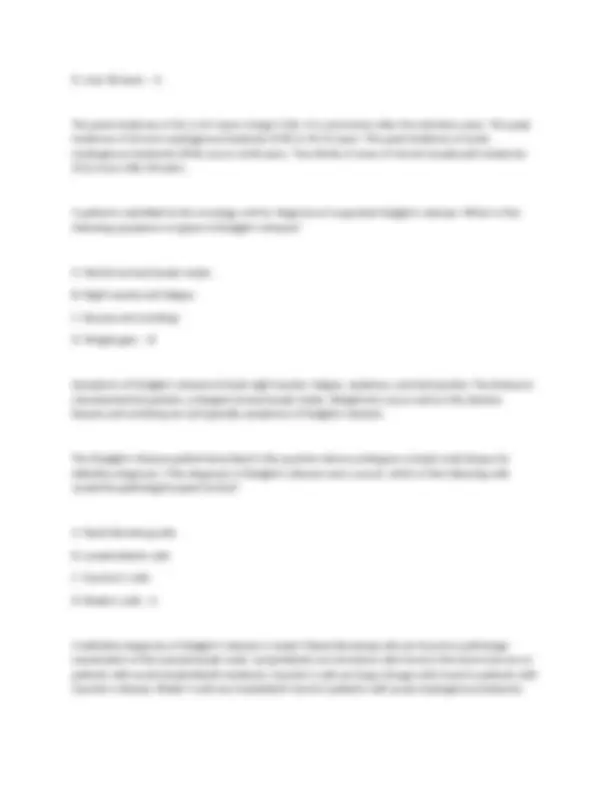
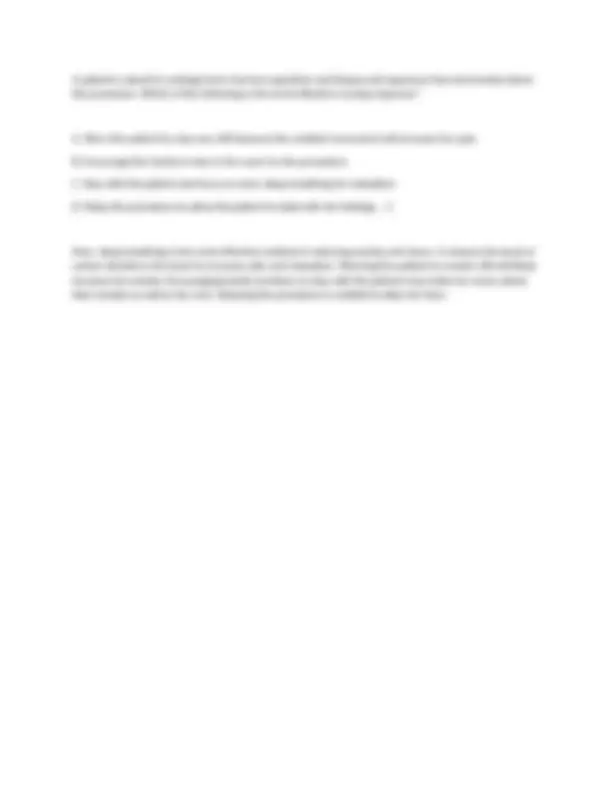


Study with the several resources on Docsity

Earn points by helping other students or get them with a premium plan


Prepare for your exams
Study with the several resources on Docsity

Earn points to download
Earn points by helping other students or get them with a premium plan
Community
Ask the community for help and clear up your study doubts
Discover the best universities in your country according to Docsity users
Free resources
Download our free guides on studying techniques, anxiety management strategies, and thesis advice from Docsity tutors
A practice test for the nclex-rn exam, which is the national council licensure examination for registered nurses. The test covers a variety of topics related to nursing care, including administering iv medications, recognizing symptoms of cardiovascular conditions, managing anemia and blood disorders, and caring for oncology patients. The questions test the nurse's knowledge of appropriate nursing interventions, patient education, and recognizing potential complications. This practice test could be useful for nursing students preparing for the nclex-rn exam, as well as for registered nurses looking to review and reinforce their clinical knowledge.
Typology: Exams
1 / 9

This page cannot be seen from the preview
Don't miss anything!






A nurse is administering IV furosemide to a patient admitted with congestive heart failure. After the infusion, which of the following symptoms is NOT expected? A. Increased urinary output. B. Decreased edema. C. Decreased pain. D. Decreased blood pressure. - C Furosemide, a loop diuretic, does not alter pain. Furosemide acts on the kidneys to increase urinary output. Fluid may move from the periphery, decreasing edema. Fluid load is reduced, lowering blood pressure. There are a number of risk factors associated with coronary artery disease. Which of the following is a modifiable risk factor? A. Obesity. B. Heredity. C. Gender. D. Age. - A Obesity is an important risk factor for coronary artery disease that can be modified by improved diet and weight loss. Family history of coronary artery disease, male gender, and advancing age increase risk but cannot be modified. Tissue plasminogen activator (t-PA) is considered for treatment of a patient who arrives in the emergency department following onset of symptoms of myocardial infarction. Which of the following is a contraindication for treatment with t-PA? A. Worsening chest pain that began earlier in the evening.
B. History of cerebral hemorrhage. C. History of prior myocardial infarction. D. Hypertension. - B A history of cerebral hemorrhage is a contraindication to tPA because it may increase the risk of bleeding. TPA acts by dissolving the clot blocking the coronary artery and works best when administered within 6 hours of onset of symptoms. Prior MI is not a contraindication to tPA. Patients receiving tPA should be observed for changes in blood pressure, as tPA may cause hypotension. Following myocardial infarction, a hospitalized patient is encouraged to practice frequent leg exercises and ambulate in the hallway as directed by his physician. Which of the following choices reflects the purpose of exercise for this patient? A. Increases fitness and prevents future heart attacks. B. Prevents bedsores. C. Prevents DVT (deep vein thrombosis). D. Prevent constipations. - C Exercise is important for all hospitalized patients to prevent deep vein thrombosis. Muscular contraction promotes venous return and prevents hemostasis in the lower extremities. This exercise is not sufficiently vigorous to increase physical fitness, nor is it intended to prevent bedsores or constipation. A patient arrives in the emergency department with symptoms of myocardial infarction, progressing to cardiogenic shock. Which of the following symptoms should the nurse expect the patient to exhibit with cardiogenic shock? A. Hypertension. B. Bradycardia. C. Bounding pulse. D. Confusion. - D
A patient received surgery and chemotherapy for colon cancer, completing therapy 3 months previously, and she is now in remission. At a follow-up appointment, she complains of fatigue following activity and difficulty with concentration at her weekly bridge games. Which of the following explanations could account for her symptoms? A. The symptoms may be the result of anemia caused by chemotherapy. B. The patient may be immunosuppressed. C. The patient may be depressed. D. The patient may be dehydrated. - A Three months after surgery and chemotherapy the patient is likely to be feeling the after-effects, which often includes anemia because of bone-marrow suppression. There is no evidence that the patient is immunosuppressed, and fatigue is not a typical symptom of immunosuppression. The information given does not indicate that depression or dehydration is a cause of her symptoms. A clinic patient has a hemoglobin concentration of 10.8 g/dL and reports sticking to a strict vegetarian diet. Which of the follow nutritional advice is appropriate? A. The diet is providing adequate sources of iron and requires no changes. B. The patient should add meat to her diet; a vegetarian diet is not advised. C. The patient should use iron cookware to prepare foods, such as dark green, leafy vegetables and legumes, which are high in iron. D. A cup of coffee or tea should be added to every meal. - C Normal hemoglobin values range from 11.5-15.0. This vegetarian patient is mildly anemic. When food is prepared in iron cookware its iron content is increased. In addition, dark green leafy vegetables, such as spinach and kale, and legumes are high in iron. Mild anemia does not require that animal sources of iron be added to the diet. Many non-animal sources are available. Coffee and tea increase gastrointestinal activity and inhibit absorption of iron. A hospitalized patient is receiving packed red blood cells (PRBCs) for treatment of severe anemia. Which of the following is the most accurate statement?
A. Transfusion reaction is most likely immediately after the infusion is completed. B. PRBCs are best infused slowly through a 20g. IV catheter. C. PRBCs should be flushed with a 5% dextrose solution. D. A nurse should remain in the room during the first 15 minutes of infusion. - D Transfusion reaction is most likely during the first 15 minutes of infusion, and a nurse should be present during this period. PRBCs should be infused through a 19g or larger IV catheter to avoid slow flow, which can cause clotting. PRBCs must be flushed with 0.45% normal saline solution. Other intravenous solutions will hemolyze the cells. A patient who has received chemotherapy for cancer treatment is given an injection of Epoetin. Which of the following should reflect the findings in a complete blood count (CBC) drawn several days later? A. An increase in neutrophil count. B. An increase in hematocrit. C. An increase in platelet count. D. An increase in serum iron. - B Epoetin is a form of erythropoietin, which stimulates the production of red blood cells, causing an increase in hematocrit. Epoetin is given to patients who are anemic, often as a result of chemotherapy treatment. Epoetin has no effect on neutrophils, platelets, or serum iron. A patient is admitted to the hospital with suspected polycythemia vera. Which of the following symptoms is consistent with the diagnosis? A. Weight loss. B. Increased clotting time. C. Hypertension. D. Headaches. - B, C, and D Polycythemia vera is a condition in which the bone marrow produces too many red blood cells. This causes an increase in hematocrit and viscosity of the blood. Patients can experience headaches,
A. Change the disposable mask immediately after use. B. Change gloves immediately after use. C. Minimize patient contact. D. Minimize conversation with the patient. - B The neutropenic patient is at risk of infection. Changing gloves immediately after use protects patients from contamination with organisms picked up on hospital surfaces. This contamination can have serious consequences for an immunocompromised patient. Changing the respiratory mask is desirable, but not nearly as urgent as changing gloves. Minimizing contact and conversation are not necessary and may cause nursing staff to miss changes in the patient's symptoms or condition. A patient is undergoing the induction stage of treatment for leukemia. The nurse teaches family members about infectious precautions. Which of the following statements by family members indicates that the family needs more education? A. We will bring in books and magazines for entertainment. B. We will bring in personal care items for comfort. C. We will bring in fresh flowers to brighten the room. D. We will bring in family pictures and get well cards. - C During induction chemotherapy, the leukemia patient is severely immunocompromised and at risk of serious infection. Fresh flowers, fruit, and plants can carry microbes and should be avoided. Books, pictures, and other personal items can be cleaned with antimicrobials before being brought into the room to minimize the risk of contamination. A nurse is caring for a patient with acute lymphoblastic leukemia (ALL). Which of the following is the most likely age range of the patient? A. 3-10 years. B. 25-35 years. C. 45-55 years.
D. over 60 years. - A The peak incidence of ALL is at 4 years (range 3-10). It is uncommon after the mid-teen years. The peak incidence of chronic myelogenous leukemia (CML) is 45-55 years. The peak incidence of acute myelogenous leukemia (AML) occurs at 60 years. Two-thirds of cases of chronic lymphocytic leukemia (CLL) occur after 60 years. A patient is admitted to the oncology unit for diagnosis of suspected Hodgkin's disease. Which of the following symptoms is typical of Hodgkin's disease? A. Painful cervical lymph nodes. B. Night sweats and fatigue. C. Nausea and vomiting. D. Weight gain. - B Symptoms of Hodgkin's disease include night sweats, fatigue, weakness, and tachycardia. The disease is characterized by painless, enlarged cervical lymph nodes. Weight loss occurs early in the disease. Nausea and vomiting are not typically symptoms of Hodgkin's disease. The Hodgkin's disease patient described in the question above undergoes a lymph node biopsy for definitive diagnosis. If the diagnosis of Hodgkin's disease were correct, which of the following cells would the pathologist expect to find? A. Reed-Sternberg cells. B. Lymphoblastic cells. C. Gaucher's cells. D. Rieder's cells - A A definitive diagnosis of Hodgkin's disease is made if Reed-Sternberg cells are found on pathologic examination of the excised lymph node. Lymphoblasts are immature cells found in the bone marrow of patients with acute lymphoblastic leukemia. Gaucher's cells are large storage cells found in patients with Gaucher's disease. Rieder's cells are myeloblasts found in patients with acute myelogenous leukemia.